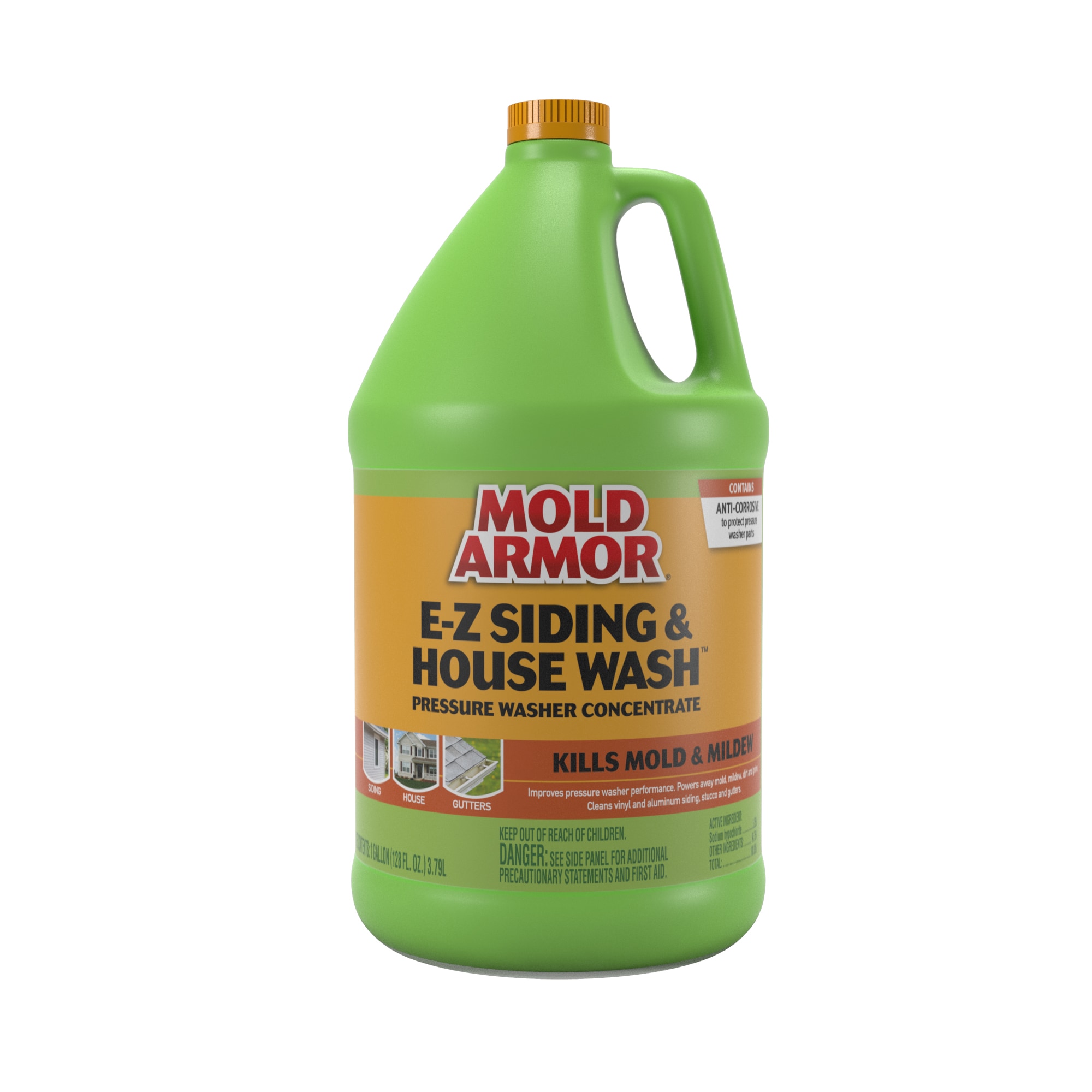If your home is starting to look a little bit dingy, it may be time for a pressure wash and remove dirt, grime, and even mildew from the house. While you could hire a professional to do this for you, it’s actually not that difficult to do yourself.
- Fill a pressure washer with a mildew-killing solution
- Set the pressure washer to a low setting and hold the nozzle about 2 feet from the surface of the house
- Slowly move the nozzle over the surface of the house, being careful not to miss any spots
- Rinse off the solution with clean water from the pressure washer
- Allow the house to air dry completely before repainting or caulking any cracks
Can You Pressure Wash Mold off Wood
If you have mold growing on your wood deck or porch, you may be wondering if you can simply pressure wash it away. The answer is maybe. Pressure washing with a high-powered machine can remove mold from many surfaces, but it’s not always effective on wood.
That’s because the spores that cause mold to grow are often embedded in the wood itself. So while pressure washing may remove some of the visible mold, it’s unlikely to get rid of all of it. And even if you do manage to remove all the mold, it will likely return quickly unless you take steps to prevent it from coming back.
If you decide to pressure wash your wood deck or porch, be sure to use a gentle setting and avoid using too much pressure. You don’t want to damage the wood or create new cracks where spores can enter and start new colonies. After pressure washing, apply a sealant or stain that contains an antimicrobial agent to help prevent future growth.
How to Pressure Wash a House With Vinyl Siding
If your home has vinyl siding, you know that it’s a low-maintenance option for keeping your house looking good. But even vinyl siding needs a little bit of care from time to time. One way to keep it looking its best is to pressure wash it on a regular basis.
Here’s how to do it:
1. Get the right equipment. You’ll need a pressure washer with at least 2,000 PSI (pounds per square inch) of pressure and a 15-degree nozzle attachment.
If you don’t have one, you can rent one from most home improvement stores. 2. Set up your pressure washer according to the manufacturer’s instructions. This usually involves connecting the garden hose to the machine and adding soap or detergent to the reservoir.
3. Begin washing at the bottom of your house and work your way up. Move the nozzle in a back-and-forth motion as you go along. Overlap each stroke by about 6 inches so you don’t miss any spots.
4. Rinse off the soap or detergent when you’re finished washing by pointing the nozzle upward and letting water flow over the siding for several minutes until it runs clear.
How to Pressure Wash a House With Bleach
If you’re looking to pressure wash your house with bleach, there are a few things you need to know. First, always use fresh bleach that’s no more than a month old. Second, make sure you dilute the bleach with water according to the instructions on the bottle.
Third, always wear gloves and protective clothing when handling bleach. Finally, be sure to rinse the area thoroughly with clean water once you’re done pressure washing.
Pressure Washing Secrets
If you’re looking to get your home clean in a hurry, pressure washing is the way to go. But before you start blasting away at all of the dirt and grime, there are a few things you should know. Here are some pressure washing secrets that will help you get the job done right.
1. Choose the right nozzle – The type of nozzle you use will determine how much water pressure you’re using. If you want a more gentle cleaning, choose a wider nozzle. For tougher jobs, go with a narrower one.
2. Start from the top – When pressure washing your house, start from the top and work your way down. This way, any dirt or debris that gets dislodged will fall down instead of being sprayed back up onto already clean surfaces.
3. Move in circular motions – When actually doing the washing, move in circular motions rather than straight lines.
This will help ensure that all areas are evenly cleaned. 4 .Don’t forget about detergent – In order to really break down all of the dirt and grime, you’ll need to use detergent along with water pressure .
Be sure to add it before you start washing for best results .
5 Overlap your strokes – As you move along , be sure to overlap each stroke by about 6 inches . This ensures that no spots are missed and that everything gets equally cleaned .
6. Rinse thoroughly – Once you’re finished , be sure to rinse off all surfaces completely with just water . Any leftover detergent can cause streaking later on once everything dries . following these simple tips , your next pressure washing project will be a breeze !
Pressure Washer Mold, Mildew Remover
If you’re looking for an effective way to remove mold and mildew from your pressure washer, look no further than a mold and mildew remover. These cleaners are specifically designed to tackle these tough stains, quickly and easily.
There are a variety of mold and mildew removers on the market, so it’s important to choose one that’s right for your needs.
For example, some cleaners contain bleach, which can be effective at removing mold and mildew but may also damage surfaces if used incorrectly. If you’re not sure which cleaner to use, consult with a pressure washing professional.
Once you’ve selected a cleaner, simply follow the instructions on the product label.
In most cases, you’ll just need to apply the cleaner to the affected areas and then rinse it away with water. However, some cleaners may require you to let them sit for a few minutes before rinsing.
After treating your pressure washer with a mold and mildew remover, be sure to keep an eye out for future growth and treat it immediately if necessary.
With regular cleaning and treatment, you can keep your pressure washer looking (and working) like new for years to come!

Credit: www.youtube.com
Does Pressure Washing Remove Mildew?
Mildew is a type of fungus that can grow on surfaces like wood, fabric, paper and tile. Pressure washing is an effective way to remove mildew from these surfaces. The high-pressure water will loosen the mildew spores from the surface so they can be rinsed away.
How Do You Get Rid of Mold And Mildew in a Pressure Washer?
If you have mold or mildew on your property, you may be wondering how to get rid of it. One option is to use a pressure washer. Pressure washing can be an effective way to remove mold and mildew, but it’s important to do it safely and correctly.
Here are some tips on how to get rid of mold and mildew with a pressure washer:
1. Use the right type of pressure washer for the job. There are two main types of pressure washers – electric and gas-powered.
Gas-powered pressure washers are more powerful than electric ones, so they’re better suited for jobs like removing mold and mildew. However, they’re also more expensive and require more maintenance than electric models.
2. Choose the right nozzle tip for your pressure washer. The nozzle tip you use will affect the power of the water stream coming out of the pressure washer. For example, a 0 degree nozzle produces a very powerful stream that can damage surfaces if not used carefully. A 40 degree nozzle produces a much gentler stream that’s less likely to damage surfaces but isn’t as effective at removing mold and mildew.
3. Set the pressure washer to the correct PSI (pounds per square inch). The PSI setting on your pressure washer determines how much water pressure is being applied to whatever surface you’re cleaning. If you set it too high, you could damage surfaces or even hurt yourself with the high-pressure water stream.
If you set it too low, the cleaning won’t be as effective because there won’t be enough power behind the stream of water. As a general rule, most experts recommend using between 1000 and 2000 PSI when cleaning mold and mildew with a pressure washer .
4 . Start by wetting down the area with plain water from your garden hose . This will help loosen up any dirt or debris that’s stuck to surfaces , making it easier for the pressure washer to remove it . Plus , starting with plain water first will help prevent any potential damage that could occur if you started with a high-pressure stream of water right away .
5 Move thenozzletipinastraightlineovertheareayouneedtocleanandavoidstaying in one spot for too long . This will help prevent damage to surfaces and ensure that the cleaning is even and thorough .
What Should You Not Pressure Wash a House With?
If you’re planning on pressure washing your house, there are a few things you should avoid doing. First, don’t use a pressure washer on painted surfaces – this can damage the paint and leave behind ugly streaks. Second, don’t use a pressure washer on delicate materials like stucco or brick – the high-pressure water can cause these materials to crack or chip.
And finally, avoid using a pressure washer on windows – the force of the water can break them. So what can you pressure wash? Just about anything else!
Driveways, sidewalks, decks, and patios are all fair game. Just be sure to start with the lowest setting first to see how your surface reacts before cranking up the power.
How Do You Clean a House With Mildew?
If you find mildew in your home, it’s important to clean it as soon as possible to prevent the spread of mold. Here are some tips on how to clean mildew:
1. Start by mixing equal parts water and white vinegar in a spray bottle.
2. Spray the affected area with the mixture and let it sit for about 30 minutes.
3. Next, use a scrub brush or sponge to remove the mildew.
4. Finally, rinse the area with clean water and dry it thoroughly.
Cleaning House Siding Mold and Algae in Five Minutes
Conclusion
If your home is starting to look a little bit run down on the outside, it may be time to give it a good pressure washing. But before you start spraying away, there are a few things you need to know. For instance, if you have any mildew on your house, you’ll want to use a pressure washer with bleach in order to kill the mold and mildew spores.
Here’s a step-by-step guide on how to pressure wash your house and get rid of that unsightly mildew.

